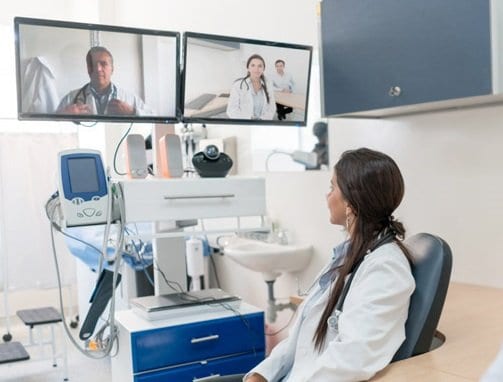Telehealth technology is changing the way we approach healthcare by enhancing patient-centered acute care, but what about long-term care?
Long-term care presents unique challenges. Historically, it’s involved paying healthcare workers to visit homes of those receiving care or on-site at facilities. Telehealth offers significant savings and a host of benefits to long-term care patients, as well as their care teams, facilities and families.
A chief concern for long-term healthcare facilities and providers is avoiding unnecessary hospital transfers and re-admittances for their patients. Telehealth technologies can reduce the number of transfers and hospital visits from long-term care facilities by addressing acute concerns on-site via video monitoring and remote consultations — especially in situations where a facility without proper resources might have previously opted for an emergency room visit.
While telehealth is beneficial to skilled nursing facilities and long-term care centers, telehealth’s greatest impact is on the patient and their family.
A patient’s personalized remote monitoring kit might contain a mobile device — such as a tablet — and monitoring technologies that capture vital physiologic data (blood pressure, peripheral capillary oxygen saturation, weight, glucose, temperature and heart rate).
A remote physician can keep an eye on a sick patient around the clock to determine whether certain symptoms develop or evolve. Based on how severe the symptoms become, the monitoring physician can recommend additional consults, treatment or hospitalization. If the situation doesn’t warrant a hospital admission, long-term care patients may avoid secondary complications such as pressure ulcers and deconditioning from prolonged hospital bed rest.
Telehealth also empowers chronic disease patients and their families. Advocates for these populations are increasingly calling for remote monitoring and wider access to specialists via video.
Too often, seniors are overlooked as a target demographic for technological advancements. While they may be later adopters, familiarity breeds adaptation.
Consider grandparents who adopt communication technologies to text and video chat with their grandchildren and families over long distances, or who make use of smart appliances and household assistants. These same seniors will feel more comfortable using telehealth technologies proactively to improve their future quality of life and long-term healthcare experiences.
It’s important to remember that long-term care isn’t limited to skilled nursing or rehabilitation facilities, or seniors. Patients requiring ongoing care for mental health or pain management, for example, can benefit from telehealth technologies.
If you’re like most healthcare providers, labor costs and poor patient outcomes are the greatest threat to your bottom line. The telehealth possibilities are unlimited when it comes to providing the highest quality long-term care. Talk to us at DGI to find out how we help health care providers enhance the delivery of long term care services with telehealth technology.

